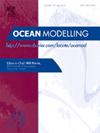Evaluating effectiveness of round-off error compensation with three methods in shallow-water models
IF 2.9
3区 地球科学
Q2 METEOROLOGY & ATMOSPHERIC SCIENCES
引用次数: 0
Abstract
High-performance computing (HPC) limitations remain a significant bottleneck in the development of numerical models. Mixed-precision techniques, which reduce arithmetic precision to improve speed and memory efficiency, offer a promising solution. However, these methods inevitably introduce increased round-off errors that may destabilize model integrations and require smaller integration steps. This study investigates whether round-off error compensation methods can mitigate such precision-reduced errors. Three widely used methods are evaluated including Gill, Kahan, and Quasi Double-Precision (QDP) within shallow-water models. The suitability of using the double-precision fourth-order Runge-Kutta (RK4-DBL) method as a benchmark is first validated through idealized 1D linear shallow-water model experiments with known analytical solutions. Subsequently, ten perturbed initial-condition experiments are conducted for 2D nonlinear shallow-water model to assess the robustness of each compensation method relative to the RK4-DBL benchmark. When applied to fourth-order Runge-Kutta (RK4) in single precision (RK4-SGL), the Gill, Kahan and QDP methods reduce surface-height root-mean-square (RMSE) errors by approximately one order, four orders, and half an order of magnitude, respectively. In terms of computational cost, runtimes increased by 53%, 4%, and 7% relative to the double-precision reference, respectively. Among these compensation methods, the Kahan method achieves the best performance in both error compensation and computational efficiency, followed by the Gill method. The QDP method, though less effective than the other two, still provides meaningful improvements. Overall, this study demonstrates that these three round-off error compensation methods can improve the accuracy of mixed-precision numerical models while maintaining a reasonable computational cost.
评估三种方法在浅水模型中舍入误差补偿的有效性
高性能计算(HPC)的限制仍然是数值模型发展的一个重要瓶颈。混合精度技术是一种很有前途的解决方案,它通过降低算术精度来提高速度和存储效率。然而,这些方法不可避免地引入了增加的舍入误差,这可能会破坏模型集成的稳定性,并需要更小的集成步骤。本研究探讨舍入误差补偿方法是否可以减轻这种精度降低的误差。对浅水模型中常用的Gill、Kahan和准双精度(QDP)三种方法进行了评价。首先通过已知解析解的理想一维线性浅水模型实验验证了双精度四阶龙格-库塔(RK4-DBL)方法作为基准的适用性。随后,对二维非线性浅水模型进行了10次摄动初始条件实验,以评估每种补偿方法相对于RK4-DBL基准的鲁棒性。当应用于单精度(RK4- sgl)的四阶龙格-库塔(RK4)时,Gill、Kahan和QDP方法分别将表面高度均方根(RMSE)误差降低了大约一个数量级、四个数量级和半个数量级。在计算成本方面,相对于双精度引用,运行时间分别增加了53%、4%和7%。在这些补偿方法中,Kahan方法在误差补偿和计算效率方面的性能最好,Gill方法次之。QDP方法虽然不如其他两种有效,但仍然提供了有意义的改进。总体而言,本研究表明,这三种舍入误差补偿方法可以在保持合理计算成本的同时提高混合精度数值模型的精度。
本文章由计算机程序翻译,如有差异,请以英文原文为准。
求助全文
约1分钟内获得全文
求助全文
来源期刊

Ocean Modelling
地学-海洋学
CiteScore
5.50
自引率
9.40%
发文量
86
审稿时长
19.6 weeks
期刊介绍:
The main objective of Ocean Modelling is to provide rapid communication between those interested in ocean modelling, whether through direct observation, or through analytical, numerical or laboratory models, and including interactions between physical and biogeochemical or biological phenomena. Because of the intimate links between ocean and atmosphere, involvement of scientists interested in influences of either medium on the other is welcome. The journal has a wide scope and includes ocean-atmosphere interaction in various forms as well as pure ocean results. In addition to primary peer-reviewed papers, the journal provides review papers, preliminary communications, and discussions.
 求助内容:
求助内容: 应助结果提醒方式:
应助结果提醒方式:


